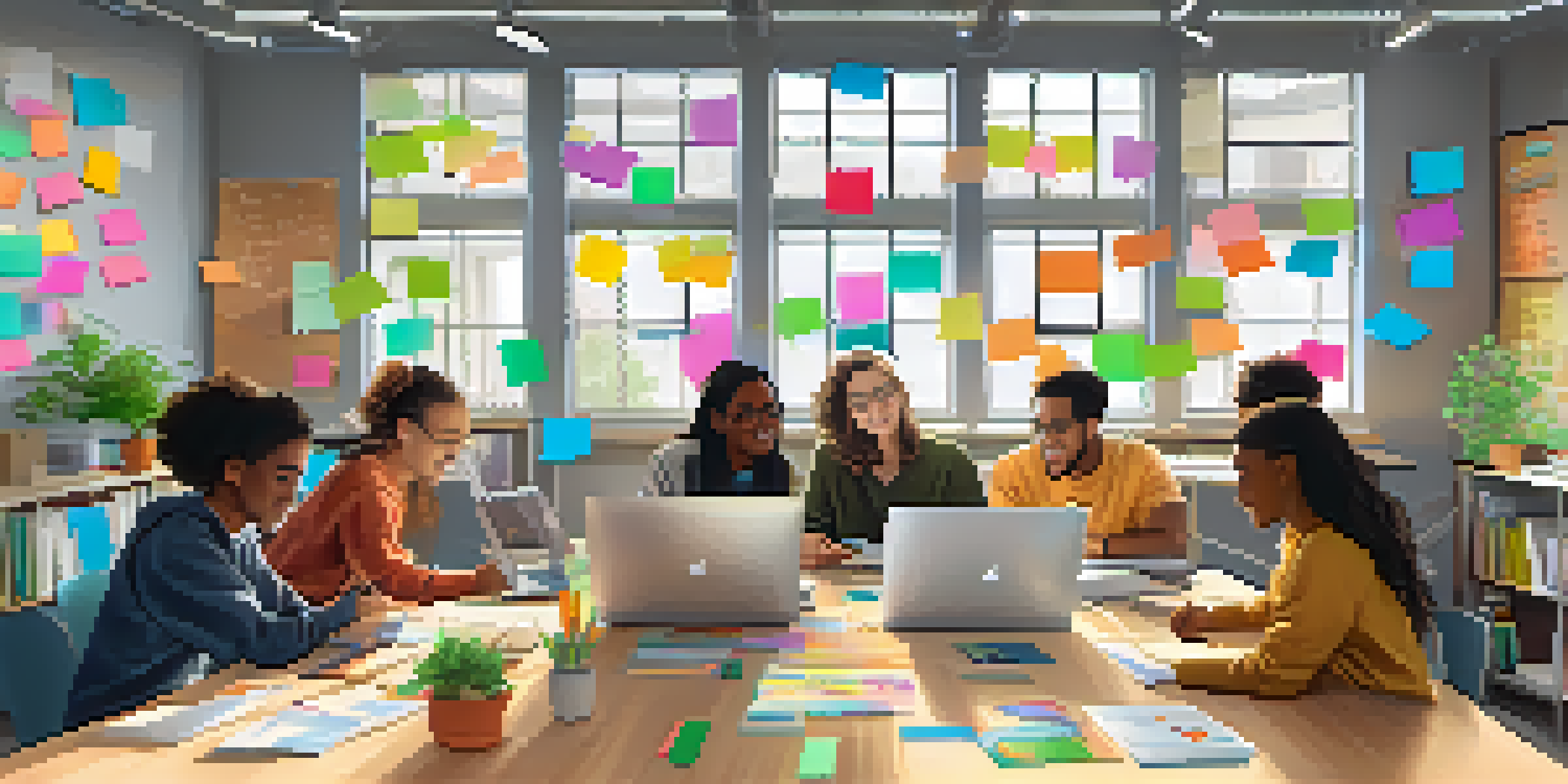Enhancing Collaboration in Learning Management Systems

Understanding the Importance of Collaboration in Learning
Collaboration in learning environments is essential for fostering engagement and knowledge sharing. When learners work together, they can tackle complex problems, share diverse perspectives, and enhance their critical thinking skills. This communal approach not only enriches the learning experience but also mimics real-world scenarios where teamwork is key.
Alone we can do so little; together we can do so much.
In today's interconnected world, the ability to collaborate effectively is a vital skill. With Learning Management Systems (LMS), educators can create spaces where students can communicate, share resources, and support each other's learning journeys. This collaborative spirit not only helps learners develop interpersonal skills but also builds a sense of community within the educational framework.
Ultimately, understanding the significance of collaboration sets the stage for implementing effective strategies in LMS. By prioritizing collaborative learning, educators can create a more dynamic and engaging educational experience that benefits all participants involved.
Leveraging Technology for Seamless Collaboration
Technology plays a crucial role in enhancing collaboration within Learning Management Systems. Features such as discussion forums, real-time chat, and shared document editing facilitate effortless communication among learners. By leveraging these tools, educators can create an interactive environment that encourages participation and dialogue.

For instance, integrating tools like Google Docs allows students to collaborate on projects in real time, regardless of their physical location. This not only promotes teamwork but also teaches learners how to work together using digital platforms, which is increasingly important in today’s workforce. Using technology effectively can transform the way students interact and learn from each other.
Collaboration Enhances Learning
Working together in learning environments fosters engagement, critical thinking, and a sense of community among students.
Moreover, the flexibility of online collaboration tools enables students to contribute at their own pace, accommodating different learning styles and schedules. This adaptability is key in fostering an inclusive environment where every voice is heard, making collaboration not just possible, but also enjoyable.
Creating Structured Collaborative Activities
Structured collaborative activities can significantly enhance the effectiveness of learning in an LMS. By designing specific tasks that require cooperation, educators can guide students toward meaningful interactions. For example, group projects, peer reviews, or discussion prompts can provide clear objectives that encourage collaboration.
Collaboration allows us to know more than we are capable of knowing by ourselves.
When activities are well-defined, students know what is expected of them and can contribute more effectively. Such structure helps to minimize confusion and keeps participants focused on their common goals. Additionally, it fosters accountability, as each member understands their role within the group.
Incorporating various types of activities, from brainstorming sessions to role-playing scenarios, can cater to diverse learning preferences. This variety not only keeps the experience fresh but also encourages students to engage with each other in different contexts, further enriching their collaborative skills.
Encouraging a Culture of Feedback and Support
A culture of feedback and support is vital for successful collaboration in LMS. When students feel safe to express their thoughts and provide constructive criticism, it enhances the overall learning experience. Encouraging this environment helps learners develop not only academically but also personally, as they learn to appreciate diverse perspectives.
Facilitating regular feedback sessions can cultivate this culture. Whether through peer evaluations or open forums for discussion, students can share insights and suggestions that promote growth. Acknowledging and addressing feedback also empowers learners, showing them that their contributions are valued.
Technology Supports Teamwork
Utilizing tools like discussion forums and shared document editing can facilitate seamless communication and collaboration among learners.
Moreover, educators can model this behavior by providing thoughtful, constructive feedback on student work. This sets a standard for how students should engage with each other, reinforcing the idea that collaboration is about mutual respect and support, ultimately leading to richer learning outcomes.
Utilizing Gamification to Foster Collaboration
Gamification is an innovative approach to enhance collaboration in Learning Management Systems. By integrating game-like elements, such as points, badges, or leaderboards, educators can motivate students to work together. This element of competition can spark enthusiasm and encourage teamwork in a fun and engaging manner.
For example, creating team challenges where groups compete to complete tasks can promote collaboration while making the learning process enjoyable. Students can strategize and share ideas, learning from one another while striving for collective success. This not only reinforces the content but also strengthens their ability to work as a cohesive unit.
Beyond motivation, gamification can also help break down barriers among students. When learners are focused on achieving a common goal, they are more likely to interact and collaborate, building relationships that might not have formed in a traditional setting. This sense of camaraderie can lead to deeper connections and a stronger learning community.
Integrating Real-World Scenarios for Collaborative Learning
Integrating real-world scenarios into collaborative learning activities can significantly enhance the relevance and impact of the experience. When students engage in projects that mimic actual challenges faced in their fields of study, they gain valuable insights and skills that are directly applicable to their future careers. This approach makes collaboration more meaningful and context-driven.
For instance, case studies or problem-solving tasks related to industry issues can propel students to collaborate effectively. Working together to devise solutions encourages critical thinking and the application of theoretical knowledge. It also prepares students for real-life teamwork, an essential skill in every profession.
Feedback Cultivates Growth
A culture of feedback and support encourages students to share insights, leading to personal and academic development through collaboration.
By connecting classroom learning with real-world applications, educators not only enhance collaboration but also increase students’ motivation and engagement. Knowing that their work has practical implications can inspire learners to invest more effort into their collaborative projects, leading to richer educational experiences.
Measuring Collaboration and Continuous Improvement
Measuring collaboration within Learning Management Systems is crucial for continuous improvement. By assessing how well students work together, educators can identify strengths and areas for growth. Tools such as surveys, peer assessments, and participation analytics can provide valuable insights into collaborative dynamics.
Establishing clear metrics for success allows educators to gauge the effectiveness of their collaborative strategies. For example, tracking the frequency and quality of interactions can reveal how engaged students are in group activities. This data can inform future instructional decisions and help tailor approaches to better meet learners' needs.

Furthermore, fostering a culture of reflection among students encourages them to evaluate their own collaborative experiences. By discussing what worked well and what didn’t, learners can develop a deeper understanding of the collaborative process, paving the way for improved teamwork in future endeavors. This cycle of measurement and reflection ensures that collaboration remains a focal point in the learning journey.